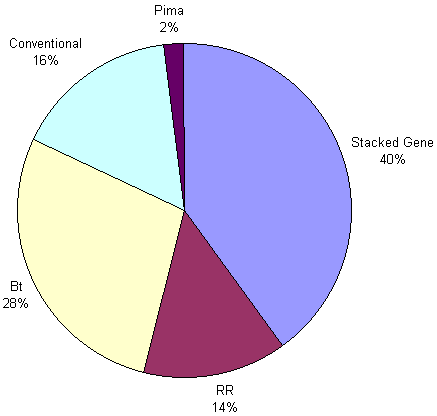Review of the 2000 Arizona Cotton Season
by Jeffrey C. Silvertooth,
Professor/Head of Department and Extension Agronomist
According to the Arizona Agricultural Statistics Service, a total of 284,000 acres were planted to cotton in 2000. Approximately 275,000 acres consist of Upland (Gossypium hirsutum L.) varieties, and 9,000 acres are planted to American Pima (G. barbadense L.) cotton. One interesting facet of cotton production in Arizona involves the use of transgenic varieties. In 1996 the first transgenic varieties were commercially introduced in Arizona and the U.S. with the first Bt varieties. As shown in Figure 1 (based on seed sales), transgenic variety use in Arizona in 2000 is approximately 82% of the total acreage. The Bt varieties have been important in Arizona, but also the Roundup Ready (RR) varieties, as well as the "stacked gene" varieties that consist of both Bt and RR characteristics have become increasingly valuable tools. In 2000, the stacked gene varieties represented approximately 40% of the total acreage. This is a notable increase over the ~14% of acres planted to stacked gene varieties in 1999.
Yield estimates have generally been very positive across the State and region this year. This can be largely attributed to the excellent weather and production conditions experienced early in the season and management that capitalized upon the opportunity to establish a good fruit load. In western Arizona (the lower Colorado River Valley) yield estimates are very good. They experienced an early crop with good quality with a much lower proportion of the crop with high micronaire values common in recent years. The rains (quite heavy in some areas) that occurred in October impacted many fields in central and eastern Arizona. This resulted in substantial delays in defoliation and harvesting. This situation was further impacted by an early frost that affected most cotton-producing areas and caused additional difficulties in defoliation and harvesting. For example, many farms in central Arizona have experienced poorer grades for fields harvested after the October rains. High micronaire values have continued to plague many fields in central Arizona in 2000, and this has impacted the statewide micronaire results for Arizona. At this writing a relatively high percentage of the Arizona Upland crop has been classed as having fiber micronaire in the discount range (>= 5.0). Thus, the high micronaire problem continues to be a critical issue for Arizona cotton production.
There are several changes taking place in the Arizona cotton industry. Arizona growers are rapidly adopting new technologies into existing and modified systems of cotton production with continuing efforts toward increasing efficiencies. For example, many growers are reducing tillage operations, maintaining or improving weed control, and drastically improving the cost of production. A number of efforts have been made to develop ultra-narrow row (UNR) production systems (=< 10 inch row spacings) in an effort to improve efficiencies. Many of the benefits attributed to UNR can be incorporated into conventional systems, such as improved water management, reduced tillage, and good weed control. Flexibility in management and the incorporation of new technologies will continue to be important features to maintaining cotton as a profitable and sustainable crop for Arizona.
The end of the 2000 cotton season also marks the end of my term as the University of Arizona Extension Cotton Specialist. On 1 July 2000, I assumed the duties as Professor and Head of the Department of Soil, Water and Environmental Science. Following a national search and screen for candidates last spring I was given the opportunity to interview with four other candidates. As it turned out I was offered the position in May, I accepted, and began the immediate transition process. I have been able to complete this past season with the obligations I had to the UA Cotton Research and Extension Programs.
I came to the UA in the spring of 1987 and have thus completed 14 seasons as the State's Cotton Agronomist. This has been a tremendous experience for me. I hold my relationships with the Arizona and regional cotton industry in highest regards. I will continue to direct an agronomic research program with a principle focus on cotton. I am very fortunate to have this opportunity to serve the University of Arizona and the College of Agriculture and Life Sciences in a new and very challenging capacity. I have always believed it is good seek and accept new challenges. I want to thank the many people that I have had the opportunity to work with over the past 14 seasons. I look forward to continuing to work with the Arizona cotton industry and the agricultural community through my new capacity.
Figure 1. Percentages of cotton types being grown in Arizona, 2000. (Source: based on seed sales in Arizona)
Issued in furtherance of Cooperative Extension work, acts of May 8 and June 30, 1914, in cooperation with the U.S. Department of Agriculture, James A. Christenson, Director Cooperative Extension, College of Agriculture and Life Sciences, The University of Arizona.
The University of Arizona is an equal opportunity, affirmative action institution. The University does not discriminate on the basis of race, color, religion, sex, national origin, age, disability, veteran status, or sexual orientation in its programs and activities.
Any products, services, or organizations that are
mentioned, shown, or indirectly implied in this web document do not imply
endorsement by The University of Arizona.
Information provided by Jeffrey C. Silvertooth, silver@ag.arizona.edu
Professor/Head of Department and Extension Agronomist, College of Agriculture, The University of Arizona.
Material written 16 December 2000.
Home | Cotton | Advisories
document located at: http://cals.arizona.edu/crops/cotton/comments/dec2000cc.html
Copyright © 2001 University of Arizona,
College of Agriculture and Life Sciences
Webmaster: Al Fournier (acis@ag.arizona.edu)
